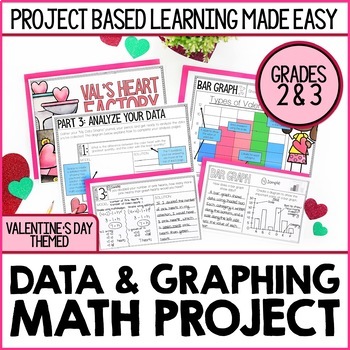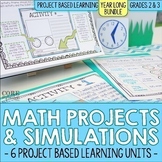Valentine's Day Math Project | Conversation Hearts Graphing Lesson & Activity
- Zip
- Google Apps™

What educators are saying
Also included in
- The 6 math projects included in this bundle are designed to help your 2nd and 3rd grade students exercise application and analysis skills for six different math topics:Place Value (Place Value in the Wild Project)Telling Time & Elapsed Time (Time of Your Life Project)Geometry (Quadrilateral CityPrice $33.96Original Price $42.45Save $8.49
Description
This Valentine's Day-themed math project introduces your students to four methods for displaying data:
- Frequency Tables
- Bar Graphs
- Pictographs
- Line Plots
Your students will record observations about each method for displaying data and compare/contrast methods for collecting data. Students will then use this knowledge to solve a problem for Val’s Heart Factory.
Love this project idea, but planning to teach graphing at a different time of year? Sal's Sweet Factory will be a perfect fit for your classroom.
***************************************************************************
APPLY GRAPHING SKILLS TO THE REAL WORLD DURING THIS PROJECT:
Take your traditional Valentine's conversation heart graphing activities to the next level with this engaging real-world project.
Val's Heart factory is having some trouble with its production line...the number of hearts being added to each of their boxes/bags of hearts is unequal.
Students will work through the following steps to help the factory solve their problem.
- Gather a sample from the factory (a box/bag of paper, foam, or candy hearts provided by you for the print version or the included digital sample for the Google Classroom version).
- Record the number of each color heart from their sample on a frequency table.
- Display their data in multiple ways using a pictograph, bar graph, and line plot.
- Analyze their data by answering questions that require them to refer to the various tables and graphs they’ve created. Each question is increasingly more challenging to build students’ data analysis skills.
- Propose a solution for Val’s Heart Factory.
- Complete a self-assessment using a four-point rubric.
A print and Google Slides digital version of this resource are both included with your purchase.
***************************************************************************
WHY TEACHERS LOVE THIS DATA & GRAPHING PROJECT:
♥ “This was an absolutely wonderful resource. It made teaching graphs soo easy!” - Anita G.
♥ “Great way to explore graphing in an engaging way around Valentine's Day!” - Carolyn G.
♥ “Amazing product. The part I liked very much was how independent my second graders were able to be when using it. This was used as part of one of our favorite math lessons for this year so far. Thank you!” - Jennifer S.
♥ “I love all of Laura's products. She is truly ahead of the curve and is inspiring me to rethink the way that I teach, from math to language, to science! Really happy with the quality and applicability of her products.” - Leigh Ann A.
♥ “My students very much enjoyed this project! We were able to dive deeper into graphing. My higher level thinkers were super interested in creating the graphs.” - Christa C.
***************************************************************************
WHAT’S INCLUDED (PRINT VERSION):
★ Teacher Guide - A 9-page guide to save you time and make prep quick and easy. This guide includes:
- Suggestions for scheduling and implementing this simulation.
- Quick prep checklists with tips from using this project in my own classroom.
- Ideas for wrapping up the simulation to boost reflection and closure.
★ Student Guide - An 11-page guide with detailed instructions and visuals to help your students complete each step of this simulation successfully. The format of this guide makes differentiation easy. Use it as a supplement to your verbal instructions as you provide scaffolding, or let your more advanced students work through each step of the project independently.
★ Data & Graphing Mini Posters - Twelve mini posters that guide students in learning about frequency tables, bar graphs, pictographs, and line plots. Three mini posters for each method of data collection are included to provide scaffolding for students as they learn about graphs and charts.
★ Data Templates - Your students will gather their own data during this simulation, and display it on a frequency table, bar graph, pictograph, and line plot. One blank template for each method for displaying data is included.
★ My Data Smarts Journal - This 18-page journal includes a summarized version of the instructions provided in the detailed Student Guide, along with pages where students record their observations about each chart/graph during the first session of the simulation. There are also pages where students answer rigorous multi-step word problems related to the data they’ve collected during the simulation.
★ Rubric - Using this 4-point rubric, students can self-assess during the course of the simulation. This rubric can also be used by you to provide a final score at the end of the simulation, making this a perfect alternative assessment for your data analysis & graphing unit.
★ Scored Samples - Scored samples for each portion of the simulation are also included in case you want to provide your students with a visual representation of each level of understanding.
★ Example Project - Completed examples of the Data Smarts Journal, frequency table, bar graph, pictograph, and line plot are also included. This example can be used as a reference for you the first time you work through this simulation with your students, or as a tool for scaffolding and differentiating for your students.
***************************************************************************
WHAT’S INCLUDED (DIGITAL VERSION):
★ Teacher Guide - A 5-page guide to save you time and make prep quick and easy. This guide includes:
- Suggestions for scheduling and implementing this simulation.
- Detailed steps for adding this project as an assignment to Google Classroom.
- Ideas for wrapping up the simulation to boost reflection and closure.
★ Google Slides Digital Student Guide - A 29-page guide with detailed instructions and visuals to help your students complete each step of this simulation successfully. The format of this guide makes differentiation easy. Use it as a supplement to your verbal instructions as you provide scaffolding, or let your more advanced students work through each step of the project independently.
★ Digital Lesson Slides - 4 detailed slides featuring different methods for collecting and displaying data. You will use these slides to teach your students about frequency tables, pictographs, bar graphs, and line plots while they take notes on each data collection method.
★ Digital Example Project - Completed examples of the entire digital project. This can be used as a reference for you the first time you work through this simulation with your students, or as a tool for scaffolding and differentiating for your students.
***************************************************************************
THE FORMAT OF THIS PROJECT
Every step of the Val’s Heart Factory experience is outlined in a project guide that includes clear visuals and step-by-step instructions. Rubrics and reflection prompts will encourage your students to reach their learning goals.
The format of this project gives students the opportunity to exercise the standards for mathematical practice, share their creativity, and display understanding in unique and engaging ways.
The format of this math simulation guide makes it an ideal resource for:
★ At your seat & hands-on enrichment during math workshop or guided math
★ Math center work
★ Digital learning (a Google Slides version of the entire project is included)
★ Parent volunteer or teacher’s aide enrichment station
★ A focal point for a data & graphing room transformation
***************************************************************************
OTHER MATH PROJECTS BY CORE INSPIRATION:
★ Place Value In The Wild - Place Value PBL Unit
★ The Time of Your Life - Telling Time Simulation
★ Sal's Sweet Factory - Data & Graphing Simulation
★ Winter Wonderland Array Architects - Arrays & Multiplication PBL Unit
★ Measure-Thon - Measurement PBL Unit
★ Quadrilateral City - Geometry PBL Unit
***************************************************************************






